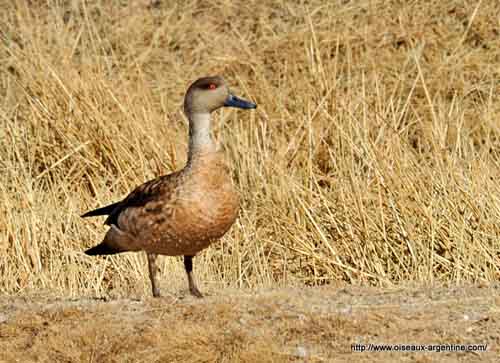
Fr: Canard huppé
All: Schopfente
Esp: Anade Juarjal - Pato Crestón - Pato juarjual
Ita: Anatra crestata
Nd: Andeseend
Sd: Tofsand
Port: Pato-de-crista
Photographers:
John Anderson
John Anderson Photo Galleries
Patrick Ingremeau
TAMANDUA
Eduardo Andrés Jordan
MIS AVES – AVES DE ARGENTINA
Otto Plantema
Trips around the world
Philippe and Aline Wolfer
OISEAUX D'ARGENTINE
Text by Nicole Bouglouan
Sources :
HANDBOOK OF THE BIRDS OF THE WORLD vol 1 by Josep del Hoyo-Andrew Elliot-Jordi Sargatal - Lynx Edicions - ISBN: 8487334105
GUIDE DES CANARDS, DES OIES ET DES CYGNES – de Steve Madge - Delachaux et Niestlé - ISBN: 2603013769
BirdLife International (BirdLife International)
Birding Patagonia – Adventure expeditions
Wikipedia, the free encyclopaedia
Crested Duck
Lophonetta specularioides
Anseriformes Order – Anatidae Family
INTRODUCTION:
The Crested Duck is a South American species, also present in the Falklands. It is the sole member of the genus Lophonetta, but it is often included by some authors in the genus Anas.
This species is very similar to the Marbled Teal which is an Old World species. Both have distinctive crest and dark mask around the eyes.

DESCRIPTION OF THE BIRD:
Biometrics:
Length: 50-60 cm
Race L.s. specularioides
Weight: M: 785-1085 g – F: 705-1030 g
Race L.s. alticola
Weight: M: 1005-1108 g – F: 914-1018 g
The adult of the nominate race may have more or less dark plumage. On the upperparts, mantle, back and scapular’s feathers are dark brown with paler centres. The wings are fairly dark or black, but we can see a metallic pinkish-copper speculum and a broad, white trailing edge. The tail is dark brown to blackish. It is pointed and frequently raised.
The underparts are pale greyish-brown with feathers showing darker centres, especially on flanks. The breast is often tinged reddish-brown. Undertail-coverts and rectrices are blackish.

On the head, we can see a crest on the nape. The dark mask around the eye and the crest are distinctive. Face, chin and neck are pale grey.
Bill, legs and webbed feet are dark grey. The eyes are red-orange in nominate race, and mostly yellowish in L.s. alticola.

Both sexes have similar appearance but the female has less distinct crest and she is slightly smaller.
The juvenile has paler mask with less black around the eyes. It lacks the crest. Its belly is paler than in adults.
SUBSPECIES AND RANGE:
There are two subspecies.
L.s. alticola is found in the Andes, from S Peru to N Argentina. This race is larger than nominate. It has yellowish eyes. The speculum is mostly purplish-green. The underparts are browner and more uniform.
L.s. specularioides (here described) is found in C Chile and W Argentina, S to Tierra del Fuego, and also in the Falklands where it is named Grey Duck.
The mainland birds are named Patagonian Crested Duck or Southern Crested Duck.

HABITAT:
The Crested Duck frequents wetlands with saline, brackish or fresh water. It can be found in marshes, lakes, coastal lagoons and pools. It favours large and shallow wetland areas, sea shores and sheltered bays.
This species occurs from sea-level up to 4000 metres in the Andes where it may breed well above 4000 metres of elevation.

CALLS AND SONGS: SOUNDS BY XENO-CANTO
The Crested Duck is usually a noisy duck. The male is strongly territorial and utters short, croaking “whorr”, or a whistled “shiii-ou”. The female produces low, repeated “kek-kek-kek” and low, barking “grruf”. She may call while sitting on the nest too. The sounds are harsher during the displays.
BEHAVIOUR IN THE WILD:
The Crested Duck of race “alticola” is usually seen in pairs or in small groups around the lakes at high elevation in the Andes. But it also feeds in coastal waters and lagoons.
After the breeding season, the birds of the nominate race “specularioides” gather in large flocks in estuaries near the coast.

The Crested Duck feeds on aquatic invertebrates, usually insects and larvae, molluscs and crustaceans. It may take some aquatic plants too. The nominate race feeds mainly on animal matter, whereas the race “alticola” prefers plant matter.
The nominate race in the Falklands feeds mainly on aquatic marine invertebrates and tiny clams. It also takes algae.
Both races feed by dabbling, wading, upending and head-dipping in shallow water and by walking at water edge. They swim and dive too.

During the breeding season, they become strongly territorial. Aggressive encounters are observed when the adults chase intruders away from the territory.
During the displays, the crest feathers are raised.
The Crested Duck is mainly sedentary but the populations breeding at high elevation usually disperse after the nesting season, and reach the coast in winter, in Buenos Aires Province.
The flight is powerful and fast.


REPRODUCTION OF THIS SPECIES:
The breeding season varies according to the range. In the Falklands, the laying occurs from August to April. In the Andes, the season takes place between October and April. They can produce 2-3 broods per season.
The Crested Duck has long-term pair-bonds. The pair nests solitary, on the ground on lakeshores or on islets. The nest is well hidden among vegetation such as grass, ferns or tussocks. The cup is lined with down and breast feathers.
It can be placed far from water, sometimes close to Kelp Gulls or skuas, or near ponds in the Falklands.

The female lays 5-8 creamy-white eggs and incubates alone during 30 days. At hatching, the chicks have dark down above with paler dorsal markings, and yellowish-white down below. The chicks of the race “alticola” have broad white eyebrows.
They are precocial and they follow their parents, feed with them and under their protection. They fledge 10-11 weeks after hatching.
PROTECTION / THREATS / STATUS:
The Crested Duck has large range where it can be fairly common and locally abundant.
The nominate race’s population is estimated 10,000/25,000 breeding pairs, with about 10,000 pairs in Falkland Islands.
The race “alticola” is estimated at about 100,000 individuals.
The Crested Duck is not currently threatened and evaluated as Least Concern.
